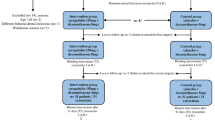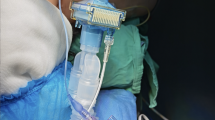Abstract
The aim of the study was to compare the effects of peritonsillar infiltration of tramadol before and after the surgery on post-tonsillectomy pain. In this double-blinded clinical trial study, 80 children aged 5–12 years old with ASA (American Society of Anesthesiologists) class I or II undergoing tonsillectomy involved. In group A (n = 40), after anesthesia induction and before starting the surgery, tramadol 2 mg/kg diluted in normal saline up to 2 cc total volume was injected into the tensile bed by the anesthesiologist using a 25 gauge needle. Surgery began 3 min later and the tonsils were removed using the sharp dissection method. In children of group B (n = 40), anesthesia induction was performed. When surgery was completed, tramadol 2 mg/kg diluted in normal saline up to 2 cc total volume was injected at the site of removing each tonsil using a 25 gauge needle by the anesthesiologist. Using the CHEOPS (Children’s Hospital of Eastern Ontario Pain Scale) Scale, pain recorded at different times. Patient sedation was recorded using the RAMSAY Sedation Scale. All the data were analyzed using SPSS 17 statistical software. Two groups significantly felt different pain intensities at different times following the surgery. At the three times, the mean sedation score in the group receiving tramadol infiltration before surgery was a little higher compared to the other group, but this difference was not significant (p > 0.05). As for the relative frequency of nausea and vomiting, the difference was not significant (p = 0.793). Request for analgesics between the groups was not significant (p = 0.556). The mean time of the first feeding after the surgery was not significant between the groups (p = 0.062). Surgical duration was almost the same for both groups (p > 0.05). Systolic blood pressures (before surgery, before extubation, and after extubation) were statistically the same in both groups (p < 0.05). Furthermore, systolic blood pressures 10, 15, and 30 min after entry into the recovery room were the same in both groups. We concluded that peritonsillar infiltration of tramadol before surgery controlled postoperative pain better from 8 h after the surgery to hospital discharge (late effect), but that local infiltration of tramadol after surgery controlled postoperative pain better up to 2 h after the operation (early effect).

Similar content being viewed by others
References
Richardson MA, Seid AB, Cotton RT, Benton C, Kramer M (1980) Evaluation of tonsils and adenoids in sleep apnea syndrome. Laryngoscope 90(7):1106–1110
Ugur MB, Yılmaz M, Altunkaya H, Cinar F, Ozer Y, Beder L (2008) Effects of intramuscular and peritonsillar injection of tramadol before tonsillectomy: a double blind, randomized, placebo-controlled clinical trial. Int J Pediatr Otorhinolaryngol 72(2):241–248
Engelhardt T, Steel E, Johnston G, Veitch DY (2003) Tramadol for pain relief in children undergoing tonsillectomy: a comparison with morphine. Pediatr Anesth 13(3):249–252
Atef A, Fawaz AA (2008) Peritonsillar infiltration with tramadol improves pediatric tonsillectomy pain. Eur Arch Otorhinolaryngol 265(5):571–574
Rosen GM, Muckle RP, Goding GS, Mahowald MW, Ullevig C (1994) Postoperative respiratory compromise in children with obstructive sleep apnea syndrome: can it be anticipated?Pediatrics 93(5):784–788
Akkaya T, Bedirli N, Ceylan T, Matkap E, Gulen G, Elverici O et al (2009) Comparison of intravenous and peritonsillar infiltration of tramadol for postoperative pain relief in children following adenotonsillectomy. Eur J Anaesthesiol 26(4):333–337
Akbay BK, Yildizbas S, Guclu E, Yilmaz S, Iskender A, Ozturk O (2010) Analgesic efficacy of topical tramadol in the control of postoperative pain in children after tonsillectomy. J Anesth 24(5):705–708
Asadi HK, Nikooseresht M, Noori L, Behnoud F (2016) The effect of administration of ketamine and paracetamol versus paracetamol singly on postoperative pain, nausea and vomiting after pediatric adenotonsillectomy. Anesthesiol Pain Med 6(1):e31210. doi:10.5812/aapm.31210
Ayatollahi V, Behdad S, Hatami M, Moshtaghiun H, Baghianimoghadam B (2012) Comparison of peritonsillar infiltration effects of ketamine and tramadol on post tonsillectomy pain: a doubleblinded randomized lacebocontrolled clinical trial. Croat Med J 53(2):155–161
Heiba M, Atef A, Mosleh M, Mohamed R, El-Hamamsy M (2012) Comparison of peritonsillar infiltration of tramadol and lidocaine for the relief of post-tonsillectomy pain. J Laryngol Otol 126(11):1138–1141
AliS M, Shahrbano S, Ulhaq TS (2008) Tramadol for pain relief in children undergoing adenotonsillectomy: a comparison with dextromethorphan. Laryngoscope 118(9):1547–1549
Uysal HY, Takmaz SA, Yaman F, Baltaci B, Başar H (2011) The efficacy of intravenous paracetamol versus tramadol for postoperative analgesia after adenotonsillectomy in children. J Clin Anesth 23(1):53–57
Cocelli LP, Ugur BK, Durucu C, Kul S, Arik H, Mumbuc S (2012) Comparison of pre-emptive tonsillar lodge infiltration with ropivacaine versus intravenous tramadol in pediatric tonsillectomies: a randomized placebo-controlled study. Int J Pediatr Otorhinolaryngol 76(5):653–657
Ciccone MM, Aquilino A, Cortese F, Scicchitano P, Sassara M, Mola E et al (2010) Feasibility and effectiveness of a disease and care management model in the primary health care system for patients with heart failure and diabetes (Project Leonardo). Vasc Health Risk Manag 6(101273479):297–305
Twycross A (2007) Children’s nurses’ post-operative pain management practices: an observational study. Int J Nurs Stud 44(6):869–881
Author information
Authors and Affiliations
Corresponding author
Ethics declarations
Conflict of interest
Hatami Maryam declares that she has no conflict of interest. Jesmani Amin declares that he has no conflict of interest. Vaziribozorg Sedighe declares that she has no conflict of interest. Ayatollahi Vida declares that she has no conflict of interest.
Ethical approval
All procedures performed in this study were in accordance with the ethical standards of the institutional and national research committee and with the 1964 Helsinki declaration and its later amendments or comparable ethical standards. This article does not contain any studies with animals performed by any of the authors.
Informed consent
Informed consent was obtained from all patients parents included in the study. This study approved by ethics committee of Shahid Sadoughi University of Medical Sciences.
Rights and permissions
About this article
Cite this article
Maryam, H., Amin, J., Sedighe, V. et al. Comparing the effects of peritonsillar infiltration of tramadol before and after the surgery on post-tonsillectomy pain. Eur Arch Otorhinolaryngol 274, 2521–2527 (2017). https://doi.org/10.1007/s00405-017-4477-z
Received:
Accepted:
Published:
Issue Date:
DOI: https://doi.org/10.1007/s00405-017-4477-z




